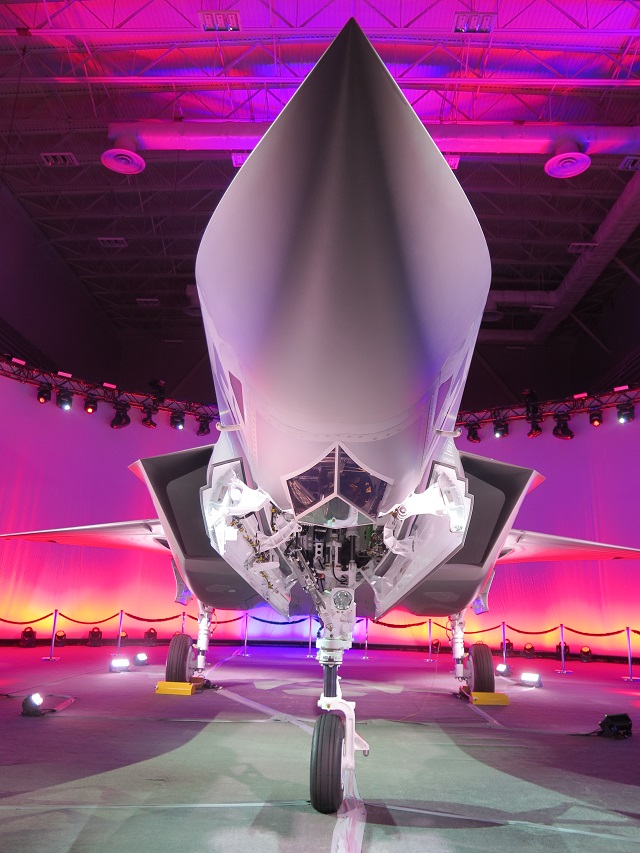Lockheed Martin has unveiled Norway’s first F-35A, marking the start of a 10-year endeavour by the Royal Norwegian Air Force (RNoAF) to phase out the Lockheed F-16 and achieve full operating capability with its stealthy, multi-role replacement, by 2025.
The long, coastal nation, which shares a border with Russia, is depending on the introduction of the F-35 to guard its high north region, and the Norwegian government has already committed to purchasing 22 of its 52-aircraft requirement.
RNoAF chief of staff Maj Gen Per Egil Rygg says the 22 September unveiling of aircraft AM-1 at the final assembly and checkout facility, in Fort Worth, Texas, is a significant milestone – but now the real work of bringing the F-35 into service begins.
“We’ve been preparing for this day for a long time, and now we get the aircraft. We can ship it over to [Luke AFB in Arizona] and we start flying it after some initial testing in January 2016,” Rygg said in an interview after the roll-out ceremony. “Now the work starts for the air force, and this is the start for the next 50 years as far as I’m concerned.”

Lockheed unveiled the first of 52 Norwegian F-35As 22 September at the production plant in Fort Worth, Texas.
James Drew/Flightglobal
Norway’s second aircraft, AM-2, will be delivered later this year. In all, four RNoAF aircraft will be stationed at the multinational pilot training school at Luke AFB and the first of 48 operational aircraft will arrive, in-country, in 2017 to support initial operational capability (IOC) in 2019.
At the ceremony, which was aired live on television in Norway, US officials heaped praise on the country for its steadfast commitment to the multibillion dollar aircraft programme, even when development problems and cost and schedule growth – which sparked a major programme rebaselining in 2010 and 2011 – threatened to derail the F-35.
Norway signed up as a programme partner in 2008, and notably increased its planned procurement quantities even as other nations reduced their numbers due to cost pressure.
Today, there is general consensus that the F-35 has turned a corner, and now the enterprise is on the cusp of a major production ramp up – from 45 aircraft this year to about 120 by 2019.
According to the Pentagon’s F-35 program executive officer Lt Gen Christopher Bogdan, the Joint Strike Fighter community will be under immense pressure over the next four years as it seeks to open 17 new F-35 operating locations around the world and increase the multinational fleet from about 150 aircraft to more than 500 by 2019. Meanwhile, the supplier base is likely to struggle to produce enough spare parts to support the growing fleet while also delivering retrofit kits and modifications for those 500 jets, which will be produced concurrently before the end of development and testing.
The programme also faces several potentially damaging obstacles that are largely outside of its control, including decisions by Denmark and Canada about whether to stay in the programme, and budget gridlock in Washington that threatens to keep the US Department of Defense's production quantities at the current level.
Speaking after the ceremony, Bogdan and Pentagon acquisition czar Frank Kendall warned about the damaging impact of another government shutdown or a year-long continuing budget resolution that would cap defence spending at FY2015 levels.
“It’s disappointing where we finally hit the point where the programme is mature enough and successful enough to begin our ramp-up, and right at the moment we step off to do that, we’re put in a situation where next year, 19 airplanes – 16 US Air Force A-models and three B-models for the Marine Corps – may not be able to be purchased,” Bogdan says.
“Those airplanes are moving down the production line today, so if we’re not able to buy them in fiscal year 2016, we’ll have to do something to ensure those airplanes eventually get bought. A disruption to the production line or the business scenario there is just disappointing.”
The programme is relying on increased quantities of orders and other measures to reduce the cost per aircraft from more than $100 million to about $85 million by 2019.
Unless the costs come down substantially, programme officials fear another cull to the procurement numbers, below the current cumulative projection of 3,170.
Lockheed F-35 programme general manager Lorraine Martin says the company is aggressively pursuing the $80-85 million aircraft cost target, and is also striving to reduce the operating and sustainment cost by 30% below current estimates.
One way to garner procurement savings and inject some much-needed budget stability into the programme is a three-year “block buy”, being considered in 2018.
Martin tells Flightglobal the three-year block buy would commit the participating governments to a certain quantity, which would drive savings and programme stability.
“Stability is very important to our programme, our supply chain and to our customers who need to depend on this aircraft,” she says.

James Drew/Flightglobal
Source: FlightGlobal.com
















